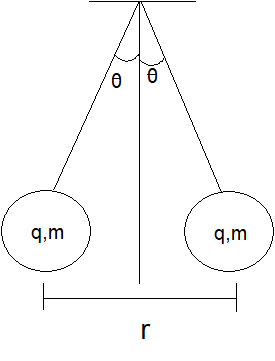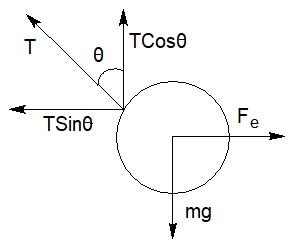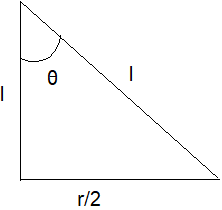
Two balls of same mass and carrying equal charge from a fixed support of length l electrostatic equilibrium, assuming that angles made by each thread is small, the separation between the balls is proportional to
A. $l$
B. ${l^2}$
C. ${l^{\dfrac{2}{3}}}$
D. ${l^{\dfrac{1}{3}}}$
Answer
218.7k+ views
Hint: Think about the condition of equilibrium. Think about electrostatic force, gravitational force and how they are acting on the balls. Apply the equilibrium condition and try to find relation between length of string and separation between them.
Complete step by step solution:
First to understand the situation clearly let’s draw the picture

According to the question, let's assume we have two balls of the same mass and charge of $q{\text{ and m}}$ respectively and the distance between them is $r$ . The whole system is in electrostatic equilibrium. A system is in equilibrium means net force on the body is zero and net torque of the body is zero. That means here the net electrostatic force of the system is zero.
Lets see what are the forces acting on the system. We can see that between charges there is always an electrostatic force. We can calculate this electrostatic force by applying coulomb's law which says that $F = k \times \dfrac{{{q_1} \times {q_2}}}{{{r^2}}}$here $F = {\text{force}}$ , ${q_1},{q_2} = {\text{charges}}$ , $r = {\text{distance between their centres}}$. Another force is gravitational force which is equal to the product of mass of the body with gravitational acceleration. Another force is shown in the figure is tension on the string. Let’s assume it as $T$ . Let’s see the free body diagram of the ball.

Observe the free body diagram carefully, for making the whole system equilibrium we have to make the sum of all forces zero. Let’s start with the horizontal direction, there are two forces. We can that from $\vec T\sin \theta + {\vec F_e} = 0$, here ${\vec F_e} = {\text{ electrostatic force}}$, $T = {\text{ tension on the string}}$.
Now its is clear to us is \[\left| {\vec T\sin \theta } \right| = \left| {\overrightarrow {{F_e}} } \right|\]. Now consider that the length of the string is $l$. Let’s find out the value of $\sin \theta $. For this first draw a triangle.

Now in this triangle $\sin \theta $ is equal to $r/2l$. Where$r = {\text{ distance between balls, l = length of string}}$ . Now put the value of $\sin \theta $ in the equation. We get $T \times \left( {\dfrac{r}{{2l}}} \right) = {F_e}$. Now the value of ${F_e} = k \times \dfrac{{{q^2}}}{{{r^2}}}$ by applying coulomb's law.
Hence,
$T = k \times \dfrac{{{q^2}}}{{{r^2}}} \times \left( {\dfrac{{2l}}{r}} \right) = k\dfrac{{\left( {{q^2} \times 2l} \right)}}{{{r^3}}}\\$
Next we have made the sum of force in the vertical direction zero. $T\cos \theta = mg$ because they are opposite directions so for making net force zero the magnitude of two forces must be the same.
From the triangle we can say that $\cos \theta = 1$ because in the question it is mentioned $\theta $ is very small. If we can say that \[T = mg\] . Then, we can compare values of $T$ getting from two equations. Let’s compare them. $k\dfrac{{\left( {{q^2} \times 2l} \right)}}{{{r^3}}} = mg$. From this equation we can say that $l$ is proportional to ${r^3}$. We can rewrite it as $r$ is proportional to ${l^{\dfrac{1}{3}}}$.
Hence, Option D is the correct answer.
Note: Equilibrium condition is that when net force and net torque the system is zero. In that type of first try to visualise the situation. Making a free body diagram makes this kind of problem easier. always breaks the force like the tension into two parts .
Complete step by step solution:
First to understand the situation clearly let’s draw the picture

According to the question, let's assume we have two balls of the same mass and charge of $q{\text{ and m}}$ respectively and the distance between them is $r$ . The whole system is in electrostatic equilibrium. A system is in equilibrium means net force on the body is zero and net torque of the body is zero. That means here the net electrostatic force of the system is zero.
Lets see what are the forces acting on the system. We can see that between charges there is always an electrostatic force. We can calculate this electrostatic force by applying coulomb's law which says that $F = k \times \dfrac{{{q_1} \times {q_2}}}{{{r^2}}}$here $F = {\text{force}}$ , ${q_1},{q_2} = {\text{charges}}$ , $r = {\text{distance between their centres}}$. Another force is gravitational force which is equal to the product of mass of the body with gravitational acceleration. Another force is shown in the figure is tension on the string. Let’s assume it as $T$ . Let’s see the free body diagram of the ball.

Observe the free body diagram carefully, for making the whole system equilibrium we have to make the sum of all forces zero. Let’s start with the horizontal direction, there are two forces. We can that from $\vec T\sin \theta + {\vec F_e} = 0$, here ${\vec F_e} = {\text{ electrostatic force}}$, $T = {\text{ tension on the string}}$.
Now its is clear to us is \[\left| {\vec T\sin \theta } \right| = \left| {\overrightarrow {{F_e}} } \right|\]. Now consider that the length of the string is $l$. Let’s find out the value of $\sin \theta $. For this first draw a triangle.

Now in this triangle $\sin \theta $ is equal to $r/2l$. Where$r = {\text{ distance between balls, l = length of string}}$ . Now put the value of $\sin \theta $ in the equation. We get $T \times \left( {\dfrac{r}{{2l}}} \right) = {F_e}$. Now the value of ${F_e} = k \times \dfrac{{{q^2}}}{{{r^2}}}$ by applying coulomb's law.
Hence,
$T = k \times \dfrac{{{q^2}}}{{{r^2}}} \times \left( {\dfrac{{2l}}{r}} \right) = k\dfrac{{\left( {{q^2} \times 2l} \right)}}{{{r^3}}}\\$
Next we have made the sum of force in the vertical direction zero. $T\cos \theta = mg$ because they are opposite directions so for making net force zero the magnitude of two forces must be the same.
From the triangle we can say that $\cos \theta = 1$ because in the question it is mentioned $\theta $ is very small. If we can say that \[T = mg\] . Then, we can compare values of $T$ getting from two equations. Let’s compare them. $k\dfrac{{\left( {{q^2} \times 2l} \right)}}{{{r^3}}} = mg$. From this equation we can say that $l$ is proportional to ${r^3}$. We can rewrite it as $r$ is proportional to ${l^{\dfrac{1}{3}}}$.
Hence, Option D is the correct answer.
Note: Equilibrium condition is that when net force and net torque the system is zero. In that type of first try to visualise the situation. Making a free body diagram makes this kind of problem easier. always breaks the force like the tension into two parts .
Recently Updated Pages
A square frame of side 10 cm and a long straight wire class 12 physics JEE_Main

The work done in slowly moving an electron of charge class 12 physics JEE_Main

Two identical charged spheres suspended from a common class 12 physics JEE_Main

According to Bohrs theory the timeaveraged magnetic class 12 physics JEE_Main

ill in the blanks Pure tungsten has A Low resistivity class 12 physics JEE_Main

The value of the resistor RS needed in the DC voltage class 12 physics JEE_Main

Trending doubts
JEE Main 2026: Application Form Open, Exam Dates, Syllabus, Eligibility & Question Papers

Derivation of Equation of Trajectory Explained for Students

Hybridisation in Chemistry – Concept, Types & Applications

Understanding the Angle of Deviation in a Prism

Understanding Collisions: Types and Examples for Students

Understanding Atomic Structure for Beginners

Other Pages
JEE Advanced Marks vs Ranks 2025: Understanding Category-wise Qualifying Marks and Previous Year Cut-offs

How to Convert a Galvanometer into an Ammeter or Voltmeter

Understanding Centrifugal Force in Physics

JEE Main Marking Scheme 2026- Paper-Wise Marks Distribution and Negative Marking Details

Degree of Dissociation: Meaning, Formula, Calculation & Uses

Understanding Electromagnetic Waves and Their Importance




